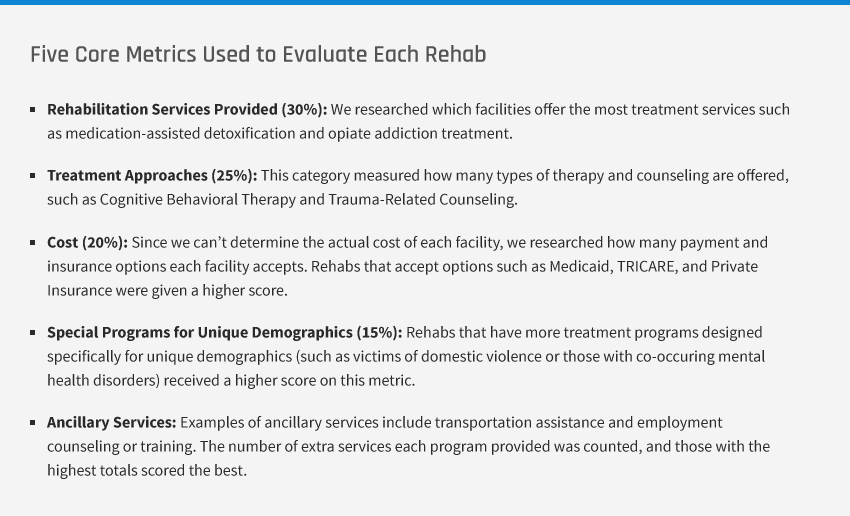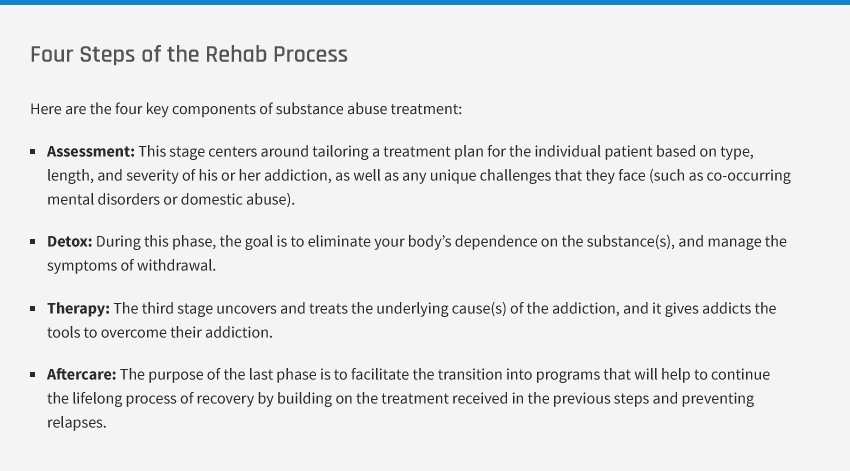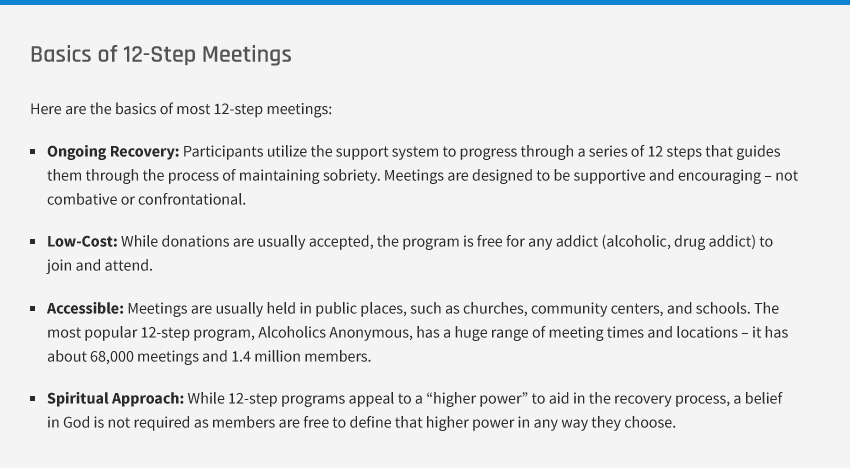Alcohol consumption is often more socially acceptable than the use of heroin, cocaine, methamphetamine, and other illicit drugs. However, local data indicate that alcohol use disorders are the most common form of substance use disorders in the San Francisco area, far outstripping those involving illicit drugs. According to a National Drug Early Warning System study, between 2012 and 2014, 8.83% of residents age 12 and older in San Francisco County self-reported having an alcohol substance use disorder, compared to 2.95% having a disorder surrounding illicit drugs.
Alcohol, Drug, and other Rehab Centers in San Francisco, CA
TABLE OF CONTENTS
Getting Help
What to Consider When Choosing a Rehab Center
When considering which treatment options and rehab programs to look into, some questions you should consider asking are:
- Which service setting is best for me? Reading the following guides will help you understand residential inpatient programs and outpatient programs.
- Which specialized rehab programs do I need? Looking into the differences between holistic rehabs, rehabs for dual diagnosis, and programs only for alcohol and drug detox can help you make an informed choice.
- How long should I stay? Exploring the differences between a shorter rehab length (30 days) or a longer-term option (60, 90, or 120+ days) will help you know what to expect.
There are various factors which will impact your rehab options, such as the severity of your addiction, your financial position, and your unique personal situation.
For useful information on how to make all of these choices, read our guide to Choosing the Right Rehab.
The Best Rehabs in San Francisco, CA
The cost of rehab can be high and varies depending on your location and particular needs. For both the insured and the uninsured, there are ways for you to connect with services that will help you in your addiction recovery journey. According to the Substance Abuse and Mental Health Administration (SAMHSA), there are 113 substance abuse treatment centers within 25 miles of San Francisco. Many of these organizations are on a mission to provide substance abuse recovery services to residents, regardless of their financial status. Out of these 113 rehabs, Marin Treatment Center Outpatient Services in San Rafael has received the highest overall scores based on our five core metrics.

We use five core metrics to evaluate the quality of each facility. For more information, feel free to read a full breakdown of our filtering process and ranking methodology.
1. Marin Treatment Center Outpatient Services
Marin Treatment Center is a non-profit that scored 5.6 out of 10 points in our rankings for its outstanding selection of substance abuse and mental health treatment options. This center serves adults and young adults of all genders and provides a variety of outpatient substance abuse rehabilitation services, including several different types of medication-assisted detoxification and a SAMHSA-Certified Opioid Treatment Program. This center also had a high score of 7.7 points for its variety of treatment approaches, such as cognitive behavior therapy, trauma-informed counseling, anger management, and more in both individual and group counseling sessions. With 22 ancillary services, this treatment center can assist clients with transportation problems, health screenings, nicotine cessation counseling, and a variety of other needs.
Marin Treatment Center scored zero points in the special programs category because it does not formally offer services for unique populations. If you’re struggling with substance abuse and also dealing with problems such as domestic violence, discrimination, a co-occurring mental health issue, homelessness, or another unique circumstance, you may find extremely helpful counseling here, but an entire program specifically tailored to your needs will not be available. If the challenges you face include more than substance abuse, you can speak with a counselor about whether or not one of the programs the center has will still be a good fit for you.
Marin Treatment Center accepts a wide variety of insurance, including Medi-Cal. It also accepts cash payments and provides a sliding-scale payment option. If you have a need for substance abuse counseling but do not have benefits or the means to pay for it alone, the sliding scale may ease your financial burden.
Scores:
- Rehabilitation Services Provided: 9.13
- Treatment Approaches: 7.7
- Cost: 2.5
- Special Programs for Unique Demographics: 0
- Ancillary Services: 4.34
2.El Centro de Libertad (The Freedom Center)
El Centro de Libertad (the Freedom Center) has been serving San Mateo County for 25 years, using outpatient therapy to help locals find victory over substance abuse. El Centro scored 5 out of 10 overall points in our rankings. This center strongly emphasizes freedom and personal dignity in recovery. Treatment approaches include relapse prevention, trauma-informed therapy, a12-step facilitation approach, and more. Since this center does not offer as many detox programs as some of the centers on our list, it scored lower in the rehabilitation services provided metric.
This center offers many special programs for unique demographics, awarding it 10 out of 10 possible points in this category. A substance use disorder is often not the only challenge a person with addiction faces. Sometimes a crisis, life changes, and transitions, or the experience of being “other” can mean a person needs extra help and specific advice. At El Centro de Libertad, there are many special groups and services tailored to the needs of those in these and other challenging circumstances. Here, adolescents, seniors, LGBTQ clients, pregnant women, veterans and military families, persons with HIV/AIDS, persons with co-occurring mental illness, and other groups can find a compassionate program that realistically addresses their lived experiences.
El Centro received a decent score for cost. Patients may use many forms of federal or government funding, pay out of pocket, or be eligible for help with payments based on their financial ability. This center is a non-profit and receives philanthropic and local government funding to operate. Services are available in Spanish as well as English.
Scores:
- Rehabilitation Services Provided: 1.66
- Treatment Approaches: 6.93
- Cost: 5
- Special Programs for Unique Demographics: 10
- Ancillary Services: 3.1
3. Mission Council on Alcohol Abuse Family Day Treatment Program
Mission Council Family Day Treatment Program focuses on offering a variety of outpatient substance abuse treatment programs in San Francisco, primarily to Spanish-speaking families and/or low-income families affected by drug or alcohol abuse. This center scored 4.6 out of 10 possible points in our rankings. Since treatment for opioid addiction is not offered, the program received zero points in the category related to available rehabilitation services. However, Mission Council on Alcohol Abuse uses 10 unique treatment approaches, including cognitive behavioral therapy, motivational interviewing, 12-step, brief intervention, rational emotive behavioral therapy and more. Nearly all of the center’s services are provided in English and Spanish, and some are also offered in Cantonese.
Mission Council has also incorporated a large number of ancillary services and programs for special demographics into its treatment model. While the offerings are too numerous to list, those who have experienced any form of abuse, poverty, discrimination, major life change, or trauma are likely to find assistance here. Mental health support, couples counseling, disease screening, and many other crucial services from this center support the long-term treatment success of the patient.
Mission Council is a center designed primarily for low-income clients, and, as such, it keeps its fees affordable. For example, a related DUI recovery program offered by the center can cost less than $90 a month. Each treatment plan may have its own cost. Payments can be made in a variety of ways, including through government benefits and insurance other than Medicaid. Some participants will be eligible for payments on a sliding scale.
Scores:
- Rehabilitation Services Provided: 0
- Treatment Approaches: 9.24
- Cost: 2.5
- Special Programs for Unique Demographics: 8.04
- Ancillary Services: 5.58
Top-Rated, Low-Cost Treatment Centers in Illinois
| Rank | Rehab | Total Score | Contact Information |
| #1 | Marin Treatment Center Outpatient Services | 5.6 | 1466 Lincoln Avenue San Rafael, CA 94901 Main Tel: 415-457-3755 |
| #2 | El Centro de Libertad (The Freedom Center) | 5.0 | 500 Allerton Street, Floor 2 Redwood City, CA 94063 Main Tel: 650-599-9955 |
| #3 | Mission Council Family Day Treatment | 4.6 | 154 A Capp Street, Room 10 San Francisco, CA 94110 Main Tel: 415-864-0554 |
| #4 | Jelani Inc.: The Family Program | 4.3 | 1638 Kirkwood Avenue San Francisco, CA 94124 Main Tel: 415-671-1165 |
| #5 | PRC Joe Healy Detoxification Program | 4.2 | 170 9th Street San Francisco, CA 94103 Main Tel: 415-777-0333 |
| #6 | Adolescent Counseling Services Adolescent Substance Abuse Treatment Programs | 4.0 | 643 Bair Island Road, Suite 301 Redwood City, CA 94063 Main Tel: 650-424-0852 Intake Tel 1: 650-424-0852 x 108 |
| #7 | HealthRIGHT 360 Asian American Recovery Services | 3.5 | 1563 Mission Street San Francisco, CA 94103 Main Tel: 415-762-3700 |
| #8 | West Oakland Health Community Recovery Center | 3.5 | 7501 International Boulevard Oakland, CA 94621 Main Tel: 510-835-9610 |
| #9 | Horizons Unlimited of San Francisco, Inc. | 3.2 | 440 Potrero Avenue San Francisco, CA 94110 Main Tel: 415-487-6700 Intake Tel 1: 415-487-6702 |
| #10 | Star Vista Insights Adolescent Treatment Program | 3.0 | 609 Price Ave, Suite 205 Redwood City, Ca 94063 Main Tel: 650-366-8436 |
Finding a Substance Abuse Treatment Center in San Francisco
Start by determining your coverage
In order to determine your best options for a rehabilitation center, you’ll need to learn about your health coverage. By contacting your private or healthcare marketplace insurance provider, you can find out which centers you are able to utilize. To learn if you qualify for low-income Medicaid services, and to determine eligibility, visit California Medicaid and reach out to the most appropriate contact. No matter the type of coverage you have, both public and private insurance companies must cover substance abuse treatment for qualified individuals.
Use our database to find a treatment center near you
The Substance Abuse and Mental Health Services Administration (SAMHSA) provides a tool that lists all of the treatment centers in the state of California that it recognizes. To use the below tool, input your zip code and select the filter icon to find relevant treatment centers near you.
Schedule an assessment
If you have insurance and are pursuing treatment that will be covered by it, your first step should be scheduling an assessment with a qualified individual, such as a counselor or therapist. Almost all facilities can provide assessments, or your primary care provider may be able to refer you. Company policies differ. Contact the companies in our database above to discover if they will provide this service.
Find a Rehabilitation Facility Near You
Filter Your Search
Popular Searches
Type Of Care
Treatment Approaches
Service Setting
Age Groups Accepted
Ancillary Services
Facility Operation
Facility Smoking Policy
Gender Accepted
Language Services
License Certification Accreditation
Payment Assistance Available
Payment Methods and Insurance Accepted
Special Programs Groups Offered
What to Expect in Rehab
Addiction treatment is a multifaceted industry, and there are numerous techniques and philosophies. As a result, the science of studying addiction is constantly changing and improving. However, the core elements of rehabilitation are very similar.

For more on what to expect in rehab, read our guide on the addiction rehabilitation process
Finding Aftercare in San Francisco
The rehabilitation process can be a lifelong venture, and without proper aftercare upon release from a rehab facility, the chances of relapse increase. Many different aftercare options provide flexibility to the community, such as follow-up visits for continued therapy, sober living homes, and group therapy. Research shows that long-term participation in aftercare activities dramatically improves the outcome of rehabilitation efforts.
Alcoholics Anonymous created the 12-step process for recovering from alcohol addiction, and today the recovery group operates nationwide. Many other organizations follow a similar recovery pattern, including NA, or Narcotics Anonymous, for those struggling with drug addictions.

Contact the appropriate local organization to find an AA or NA meeting near you
See our directory tool below to find local organizations that can help you find your local Alcoholics Anonymous (AA) or Narcotics Anonymous (NA) group meetings. Meeting times and locations change periodically, it is best to call ahead to make sure the online information is accurate.
Alcoholics Anonymous (AA) and Narcotics Anonymous (NA) Database
| Name | City | Program | Telephone | Spanish Hotline |
|---|
Sober Living Homes
For those who are leaving behind old patterns of addiction, sober living homes, or recovery residences, can facilitate increased independence and functionality in society by helping residents to maintain sobriety. No-tolerance policies towards drugs and alcohol combined with a supportive and positive environment are particularly helpful to addiction recovery. Research shows that people who integrate into a community that rewards productivity, especially the cultivation of skills that could be used to find stable employment and build healthy relationships, have the best long-term outcomes. Structured and incentivized programs encourage those persons to focus on building a life outside of their addiction and breaking free of the cycle of substance abuse.
People in sober living are expected to care for their homes as if they were renting. Residing in a sober living situation may entail chore assignments and rent payments, as determined by the program. Support groups in each home are based upon house principles, and attendance is typically mandatory. Residents are usually welcome to stay from a few months to as long as several years if they abide by the rules and avoid relapse, as these homes have zero-tolerance drug use policies.
You can find halfway houses located in San Francisco by checking our database, or you can select the appropriate filter from our tool above. Alternatively, you can head to our guide on sober living homes and learn more about them, as well as search for a certified recovery residence in your area.
Substance Abuse in San Francisco
San Francisco is experiencing a concerning uptick in methamphetamine use
In 2013, methamphetamine use was the primary reason for admissions to substance use disorder (SUD) treatment programs in San Francisco in just 14.6% of cases, but, by the end of 2017, the percentage reached 19%. In 2014, methamphetamine replaced cocaine as the third most common primary-abused substance that led to treatment admission.
Further statistics, such as a rise in prevalence of methamphetamine overdose deaths per 100,000 people from 1.8 in 2008 to 11.5 in 2017 – an increase of 539% – heavily supports the claim that methamphetamine is a growing source of concern. In April 2019, the San Francisco Department of Public Health created the Methamphetamine Task Force as a response to this public health crisis.
Alcohol abuse affects the San Francisco County population at a disproportionately high rate
8.83%
of San Francisco population self-reporting alcohol use disorder, 2012-2014
2.9%
of San Francisco population self-reporting illicit drug use disorder, 2012-2014
8.83%
San Francisco population alcohol use disorder, 2012-2014
6.2%
United States population alcohol use disorder, 2014
The 2014 National Survey on Drug Use and Health determined that 6.2% of persons over the age of 12 nationwide are afflicted with an alcohol use disorder, also referred to as “heavy alcohol use.” The 2014 time frame of this national study does not precisely align with the 2012 to 2014 San Francisco study; however, the available data do highly suggest that San Francisco residents struggle with alcohol use disorders at a higher rate than the general U.S. population.
Furthermore, a more recent survey revealed that San Francisco County has the highest rate of excessive drinking, otherwise known as heavy drinking or binge drinking, in the state. 24% of adults in San Francisco County reported excessive drinking in 2016, compared to a state average of 18%.
San Francisco County has a lower percentage of drug and alcohol-induced deaths than the nation
7.66%
of SF county deaths are caused by drugs and alcohol
12.71%
of US deaths caused by drugs and alcohol
From 2008 to 2017, there were 4,675 deaths induced by drugs and/or alcohol in San Francisco County. This equates to 7.66% of the total number of deaths among all ages in the county during that time frame. Any percentage of deaths from drug and alcohol represents a significant loss to the community. However, the percentage of San Francisco County’s drug and alcohol-induced deaths is 5.05% lower than the percentage of deaths attributed to drugs and alcohol in the United States during the same time period.
Drug and Alcohol-Induced Deaths In San Francisco County Between 2008 and 2017
| 0-17 | 18+ | All Ages | |
| Drug-Induced Deaths in SF County | 4 | 2,570 | 2,574 |
| Alcohol-Induced Deaths in SF County | 2 | 2,099 | 2,101 |
| Total Deaths in SF County | 441 | 60,566 | 61,027 |
| Percentage of Drug & Alcohol-Induced Deaths in SF County | 1.36% | 7.71% | 7.66% |
Data gathered from CDC Wonder
Key Indicators of Substance Abuse
It’s not always clear at first glance just how many people in a society are struggling with substance abuse and its effects. By looking at several key areas we can see the larger impact of substance abuse in San Francisco County. Statistics from this section are taken from suicide rates, homeless surveys and traffic reports across the area that give a broader view of substance abuse issues and their impact in San Francisco.
Drug-related suicides in San Francisco experienced a sharp decline in recent years
Substance use disorders have a relationship to suicidal thoughts and actions that is difficult to quantify in surveys. According to the 2015 National Survey on Drug Use and Health titled “Suicidal Thoughts and Behavior among Adults,” it’s not always known which percentage of the population has suicidal tendencies that are caused by substance abuse and which percentage uses substances as an attempt to self-medicate and relieve their psychological pain.
While the relationship to ongoing suicide and substance use problems may be puzzling, there is at least some encouraging news for San Francisco in relation to suicide statistics. The most recent statistics available for San Francisco County reveal that, after about four years of steady increase, the county’s overall number of suicides took a sharp downturn in 2017-2018. The total number of suicides decreased from 136 in 2016-2017 to 94 in 2017-2018, a reduction of 30%. Drug-related suicides – meaning intentionally fatal drug overdoses – also took a significant downturn, decreasing from 20 in 2016-2017 to four in 2017-2018.
Substance abuse is a significant cause of homelessness in San Francisco
Along with many other cities in the United States, San Francisco conducts a point-in-time count of sheltered and unsheltered homeless persons every two years. The total number of homeless persons in the city was 7,499 in 2017, a slight decrease from the 2015 count of 7,539 total homeless persons.
41%
of homeless persons reporting substance abuse problems, 2017
15%
of homeless persons reporting substance use caused homelessness, 2017
During the 2017 point-in-time count, a random sampling of 1,104 of the total homeless population also took part in a focused survey. 41% of these individuals self-reported presently suffering from a drug or alcohol abuse disorder. Additionally, data from 2017 and prior survey years indicates that substance abuse is a significant cause of homelessness in the city. The percentage of individuals citing substance abuse as the main factor in their homelessness has been fluctuating over the past decade, charting at 20% in 2011, 11% in 2013, 18% in 2015, and 15% in 2017.
Alcohol-related driving deaths are lower in San Francisco County than in California
11%
of alcohol-related traffic fatalities in San Francisco County, 2013-2017
30%
of alcohol-related traffic fatalities in California, 2013-2017
Traffic fatalities for which alcohol is a factor can be an indicator of substance abuse issues in a given area. Thankfully, San Francisco’s percentage of alcohol-related driving deaths has decreased in recent years. Between 2013 and 2017, San Francisco County reported the second lowest rate in the state, with 11% of traffic fatalities – 18 of 167 – blamed on alcohol impairment.
This relatively low percentage of alcohol-related traffic fatalities in comparison to other California counties and California as a whole is likely due to the emergence of ridesharing as a convenient and inexpensive driving alternative, rather than an actual reduction in heavy drinking. In fact, the data suggests that alcohol use disorders have remained fairly stable in the area despite the improvement of this indicator. Disproportionate difficulty in finding parking in San Francisco compared to other cities may also be incentivizing people to avoid driving in general.
Take Action
There are multiple resources in and surrounding San Francisco for those who struggle with substance use disorders and dependency. You can use our tool to find a rehabilitation center near you that can help you determine your insurance coverage and rehab needs. Low-cost centers can help you if you don’t have insurance or feel like you are unable to afford treatment.


